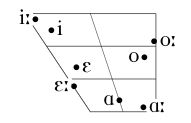| Dental | Alveolar | Palato-Alveolar | Palatal | Velar | Labio-Velar | Glottal | |
| Voiceless Unaspirated Stops and Affricates |
t̪ (t_d) |
ts | ʧ (tS) | k | kw | ʔ (?) | |
| Voiced Unaspirated Stops and Affricates |
d̪ (d_d) |
dz | g | gw | |||
| Voiceless Fricatives | s | ʃ (S) | |||||
| Voiced Fricatives | z | ||||||
| Nasals | n̪ (n_d) |
n | ŋ (N) | ||||
| Voiceless Nasals | n̪̊ (n_d_0) |
||||||
| Tap | ɾ (4) | ||||||
| Voiceless Tap | ɾ̥ (4_0) | ||||||
| Voiceless Approximant | h | Voiced Approximant | ɦ (h\) | ||||
| Semivowels | j | w | |||||
| Voiceless Semivowels | j̥ (j_0) | w̥ (w_0) |
Notes on the Consonants
All voiceless stops are unaspirated, meaning that the voicing for the next vocalic segment begins at the same time as when the articulators of the stop come apart. A similar pattern occurs with voiceless fricatives.
All voiced stops are fully voiced; that is, there is voicing during the entire duration of the stop. The same pattern also holds for voiced fricatives.
All affricates behave like stops in terms of voicing. Additionally, all affricates are homorganic. Thus, the stop articulation of [ts] and [dz] is further back than plain dental [t̪] and the stop articulation for palato-alveolar affricate [ʧ] is further back still.
The sounds [s] and [z] are articulated with the tongue tip (thus, they are apical), as are their dialectal variants [ʂ] (s`) and [ʐ] (z`). The palato-alveolar fricative, [ʃ], in constrast, is laminal, articulated with the tongue blade.
The taps are articulated with a single ballistic motion by the tongue tip against the alveolar ridge.
The sound [h], though classified as an approximant above, is articulated as in English (and many other languages) with a breathy bunch of white noise. The sound [ɦ] is like [h], with a breathy bunch of voiced, white noise.
The Vowels
There are eight vowel phonemes in Skerre. Their places within the acoustic vowel space are shown by the targets given in the following chart.

The realization of vowel phones in Skerre involves two important dimensions: their quantity and their quality. In terms of quantity, the long vowels (marked with the colon) are more than double the duration of the short vowels, although there is a fair amount of variation, depending on which vowel is it, the vowel's position in the word, its position in the utterance, and on the individual qualities of the speaker. (This kind of variation is found throughout the vowel system, meaning the targets given above and discussed below are only general guides).
In terms of quality, as the above chart shows, the short vowels are more centralized than there long counterparts. Thus, short [i] approaches [ɪ]; short [ɛ] approaches [e], short [ɑ] approaches [ɐ], and short [o] approaches [ɔ]. This trait is more pronounced in fast speech than in careful speech.
Coarticulation Effects
Skerre has a number of only slightly perceptible phonetic effects created by the adjacent sounds. This section will describe them.
When preceding or following a [i]/[ɪ] or [o]/[ɔ], most consonants are co-articulated with the respective palatal (Cj) or labial articulation (Cw). Exceptions included those consonants with a co-articulated element (as in Cw), those articulated near the palatal region [ʧ, ʃ] (in the pre-[i]/[ɪ] environment only) or are [j] or [w].
Adjacent vowels also affect each other. Thus, all vowels are a bit more towards the rounded before [o], a bit more lowered before [a], and a bit more fronted before [i]. Note that this is a bit of a non-local action, as the vowels aren't string-adjacent to each other.
Finally, before all nasal consonants, vowels are partially nasalized.
As will become clearer from the next two sections, there are further alternations similar the above that are more drastic in their changes to the sounds and have become more deeply embedded into the phonological part of the grammar.
The Phonemic Inventory
Given below is the set of contrastive sounds in Skerre. The bold IPA characters at the top of each cell are the phoneme symbols (the symbols are, to a certain extent, arbitrary). Below them, in italics, are the various allophones that make up each phoneme, also in IPA.
The Consonants
| Stops and Affricates | t t̪, d̪, ts |
ts ts, dz, ʧ |
k k, g |
kw kw, k, gw |
ʔ ʔ |
|
| Fricative | s s, z, ʃ |
|||||
| Sonorants | n n̪, n, n̪̊, ŋ |
r ɾ, ɾ̥ |
||||
| Approximants | j j, j̥ |
w w, w̥ |
h h, ɦ |
|||
The Vowels
| i i~ɪ |
i: i: |
||||||
| e e~ɛ |
e: ɛ: |
o o~ɔ |
o: o: |
||||
| a ɑ~ɐ |
a: ɑ: |
||||||
These charts, in effect, are a summary of the fourth page, which deals with the relationships between the allophones. However, before I detail the relationships between the allophones, I want to describe the closely related topic of what are the allowed combination of phonetic segments — the phonotactics of Skerre.
Forward to Section 3: Phonotactics
Back to Section 1: Introduction
The Grammar Main Page